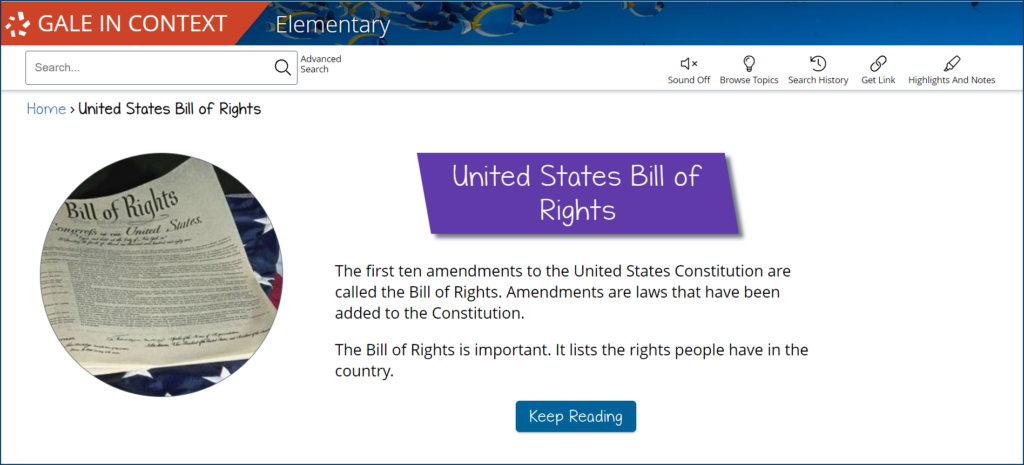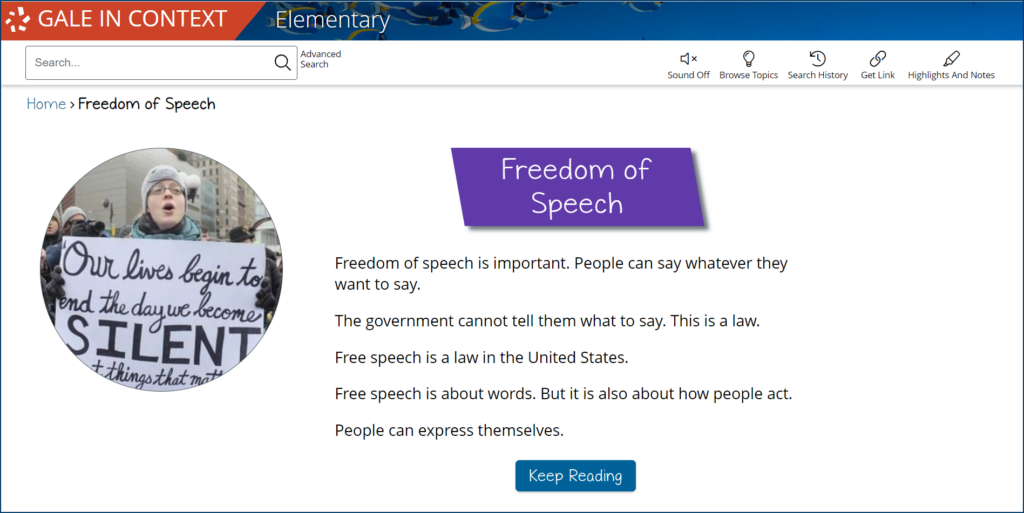Your elementary students are likely familiar with the basics of the U.S. Constitution and the lore of the Founding Fathers. As such, Bill of Rights Day on Friday, December 15, allows educators a chance to expound upon those critical concepts of human rights and basic freedoms while exploring the later amendments’ intricacies as well. To help you with this endeavor, take advantage of the resources in Gale In Context: Elementary. With our dedicated Bill of Rights portal, your students can learn about the pillars of American democracy and develop a richer understanding of their rights and responsibilities as U.S. citizens.

Gale In Context: Elementary is your go-to research database for early learners. User-friendly and age-appropriate, Elementary features simple navigation workflows and colorful visual aids to engage beginning researchers. This resource provides the building blocks for critical thinking and advanced learning. Our Bill of Rights collection is a one-stop shop for related media, including book entries, magazine articles, and pictures. The portal’s diverse materials and built-in reading level options lend to improved accessibility for different learning styles.
This December, leverage Elementary’s dedicated Bill of Rights collection to observe Bill of Rights Day or launch a more in-depth unit on citizenship. This curated, time-saving resource makes building an engaging lesson plan that inspires developmental research skills and meets students’ individual needs easy. Read three ways to engage your elementary students for Bill of Rights Day:
1. Discover the First 10 Amendments
The Bill of Rights is more than a simple document. From free speech to fair trials, some basic protections rely on the language in this centuries-old artifact. Before diving in, guide your elementary learners to Gale’s helpful Bill of Rights summary page. With its built-in accessibility features, your students can toggle between reading levels and access audio and translation tools, allowing them to gain a solid foundation for this vital topic.
You can also take advantage of Gale’s “Words to Know” feature and work through more challenging vocabulary. As a class, consider the definitions for words like “constitution,” “amendment,” or “rights.” Then, begin outlining what the different amendments mean. You can find a full list of the 10 Amendments in Gale’s Bill of Rights portal. As you work through the list, encourage students to consider why Americans felt the need to outline and codify these protections.
Activity Idea: Let your students test their knowledge! Gale has ready-made quizzes that you can easily adapt to your classroom. Have students work in teams to match each of the 10 Amendments to their descriptions.
2. Discuss the Later Amendments
Citizenship is a living, breathing concept. As the world changes, so must our freedoms and protections. After all, 18th-century leaders could not predict how the United States would evolve as a society. In fact, the most recent amendment, the 27th Amendment, wasn’t added until 1992. Some of the later revisions are just as influential as the initial 10; some are instrumental to modern-day freedoms, such as those that define the right to vote regardless of gender or race.
You can leverage your discussion on the later amendments to the U.S. Constitution to discuss how the law can change alongside social, technological, and political advancements. Of course, changing a law is easier said than done. Have your students reflect on any legal issues or debates they’ve heard about. For example, laws around immigration, gun control, and voting rights are frequently in the news and the subject of intense nationwide debate. What laws are gaining traction in your state? To help you and your students learn more, Gale in Context: Elementary is constantly updating its databases to feature current, reliable news sources.
Discussion Idea: Assign students to one of the later amendments (you could do teams of two or three, depending on your class size). Have each team thoroughly research the history and meaning behind their designated constitutional change. Many of these amendments have several sections requiring careful interpretation. Encourage each group to share what they learned with the class, specifically noting the historical context for each amendment.
3. Consider Modern Day Application
With Gale In Context: Elementary’s Bill of Rights collection, your students will learn about the fundamental protections offered to all U.S. citizens. But how do those rights apply to the modern day, and do they make sense in the context of the 21st century? After all, the Founding Fathers didn’t know about social media when they codified free speech. They couldn’t predict machine guns when they protected the right to bear arms. With a critical eye, you can work through the Bill of Rights with a modern-day perspective.
Gale’s Bill of Rights portal provides quick links to other relevant topics. Browse the Freedom of Speech collection and find recent articles addressing the nuances of free speech and the internet. Or comb through the Freedom of the Press collection and consider how it applies to “fake news.” These are complicated concepts, but using Gale In Content: Elementary ensures your young learners only access neutral, vetted information appropriate for the elementary level.
Discussion Idea: The Constitution does not limit the amount of amendments. Ask your students what is missing from the current list. What might they choose if they could add one amendment to the U.S. Constitution? As a class, make a list of everyone’s ideas and consider holding a vote for their favorite amendment.

One of the greatest assets of your Gale subscription is the database’s attention to individual student needs. However, hardworking teachers deserve that same level of support. That’s why Gale’s educational experts have created Gale In Context: For Educators. Featuring ready-made, curriculum-aligned lesson plans, collaboration tools, training webinars, and how-to guides, you can optimize your Gale resources and have more time to work on your professional goals (or even a little self-care).
With Gale in Context: Elementary and Gale In Context: For Educators, you can end the fall semester with a meaningful and engaging lesson on the Bill of Rights. Guide students to better understand their role within a democracy and inspire compassion for those worldwide who lack protections for fundamental human rights. After all, these truths are only self-evident when individuals fight for them.
For Bill of Rights Day or any lesson plan theme, you can rely on the accuracy and accessibility of Gale databases. If your institution isn’t a current Gale subscriber, learn more by visiting our website.

